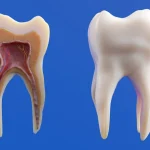Infection from root canal procedures can occur in a small percentage of cases, despite the high success rates of endodontic treatment. Understanding the warning signs is crucial for maintaining optimal oral health and preventing serious complications.
While root canal treatments boast success rates ranging from 86% to 98%, recognizing when complications arise can mean the difference between saving your tooth and facing more extensive dental work.
Table of Contents
ToggleDemystifying Root Canal Infection
A root canal infection occurs when bacteria enter or remain within the treated tooth’s inner chambers after the initial procedure. These infections can develop immediately following treatment or emerge months to years later, often catching patients off guard. Research indicates that approximately 3% of root canal procedures may experience post-treatment infections, though this rate varies based on multiple factors.
The complexity of tooth anatomy, particularly in molars with multiple canals, contributes to the risk of incomplete bacterial removal during the initial treatment. Additionally, factors such as delayed crown placement, tooth fractures, or compromised restorations can create pathways for bacterial reentry.
Let’s dive deep into the signs of root canal infections:
1. Persistent and Severe Pain
Root canal infection symptoms most commonly manifest as persistent, throbbing pain that differs significantly from normal post-treatment discomfort. While mild pain for several days after root canal treatment is expected, symptoms of a root canal infection include pain that worsens over time or fails to improve after the first week.
This pain typically presents as sharp, shooting sensations when biting down or applying pressure to the treated tooth. Unlike normal healing discomfort, symptoms of root canal pain associated with infection intensify rather than subside, often radiating to the jaw, face, or ear. The pain may be constant and throbbing, significantly impacting daily activities such as eating, sleeping, and speaking.
Patients experiencing severe pain beyond the expected recovery period should contact their dental provider immediately, as this often indicates bacterial persistence or reinfection within the tooth structure.
2. Swelling and Inflammation
Visible swelling around the treated tooth area represents one of the most concerning signs of root canal infection. This swelling can manifest in various ways, from localized gum inflammation to facial swelling that may extend to the neck region.
Jaw infection after root canal symptoms include progressive swelling that doesn’t respond to over-the-counter anti-inflammatory medications. The affected area often feels warm to the touch and appears red or discolored. In severe cases, facial swelling can restrict mouth opening or cause difficulty with speech and swallowing.
When swelling persists beyond 72 hours or worsens after initial treatment, it typically indicates an active infection requiring immediate professional intervention.
3. Tooth Discoloration and Changes in Appearance
Side effects of root canal infection often include noticeable changes in the treated tooth’s appearance. The tooth may develop a gray, brown, or black discoloration, particularly noticeable when compared to adjacent teeth. This darkening occurs due to bacterial byproducts and the breakdown of remaining organic material within the tooth structure.
Additionally, infected teeth may appear slightly elevated in their socket or feel loose when touched. These changes result from inflammatory processes affecting the periodontal ligament and surrounding bone structure. The tooth’s altered appearance often serves as an early visual indicator of developing infection.
4. Sensitivity to Temperature and Pressure
While some sensitivity following root canal treatment is normal, persistent or worsening sensitivity to hot and cold temperatures indicates potential root canal infection symptoms. This sensitivity differs from normal post-treatment discomfort because it typically intensifies over time rather than gradually improving.
Patients may experience sharp, electric-like pain when consuming hot beverages or cold foods. Additionally, sensitivity to pressure when chewing or tapping the tooth suggests inflammation of the surrounding tissues. This type of sensitivity often indicates that the infection has spread beyond the tooth’s root system.
5. Foul Taste and Bad Breath
Symptoms of a root canal infection frequently include persistent bad breath or an unpleasant metallic taste in the mouth. These symptoms result from bacterial toxins and infected tissue breakdown within the tooth structure. Unlike temporary bad breath from poor oral hygiene, infection-related halitosis persists despite thorough brushing and mouthwash use.
The foul taste may be particularly noticeable in the morning or become more pronounced throughout the day. Some patients describe the taste as bitter, metallic, or similar to rotting organic matter.
6. Pus Discharge and Drainage
The presence of pus or unusual discharge around the treated tooth represents a clear indication of active infection. This infection from a root canal may appear as yellow, green, or blood-tinged fluid emerging from the gum line near the affected tooth.
In some cases, a small bump or “gum boil” may develop near the infected tooth, serving as a drainage point for accumulated pus. This abscess formation indicates that the infection has spread beyond the tooth’s root system into surrounding tissues.
7. Systemic Symptoms and Fever
When root canal infection symptoms progress, patients may develop systemic signs of infection, including fever, fatigue, and general malaise. These symptoms indicate that the bacterial infection may be spreading beyond the localized tooth area.
Fever accompanying dental pain suggests the body is mounting a significant immune response to combat infection. Additional systemic symptoms may include swollen lymph nodes in the neck or jaw area, chills, and a general feeling of being unwell.
If a root canal gets infected and spreads systemically, it can lead to serious complications, including cellulitis, Ludwig’s angina, or, in rare cases, sepsis. These conditions require immediate medical attention and aggressive antibiotic therapy.
8. Gum Changes and Tissue Abnormalities
Signs of root canal infection often manifest as changes in the gum tissue surrounding the treated tooth. The gums may appear red, swollen, and tender to the touch. In some cases, patients may notice the development of recurring pimple-like bumps on the gums near the affected tooth.
The tissue may feel spongy or abnormally soft, and light pressure may cause bleeding or discharge. Chronic inflammation can lead to gum recession around the infected tooth.
9. Difficulty with Normal Function
Jaw infection after a root canal can significantly impact normal oral function. Patients may experience difficulty opening their mouth fully, problems with chewing, or pain when speaking. These functional limitations often indicate that the infection has spread to surrounding tissues.
The affected tooth may feel different when biting down, as if it’s sitting higher than adjacent teeth. This sensation results from inflammatory swelling of the periodontal ligament surrounding the tooth root. Normal chewing patterns may become altered as patients unconsciously avoid using the affected area.
10. Recurring or Worsening Symptoms
The most concerning symptoms of a root canal infection involve the return of pre-treatment symptoms or the development of new problems after an initial period of improvement. Patients who experienced relief following their root canal procedure but then developed recurring pain, swelling, or sensitivity should seek immediate evaluation.
These recurring symptoms may appear months or even years after the initial treatment.
Risk Factors and Contributing Conditions of Root Canal Infection
Several factors increase the likelihood of developing root canal infection symptoms. Complex tooth anatomy, particularly in molars with curved or narrow canals, makes complete bacterial elimination challenging during initial treatment. Additionally, delayed placement of permanent crowns leaves treated teeth vulnerable to bacterial reentry.
Patient-specific factors such as compromised immune systems, diabetes, or other systemic conditions can impair healing and increase infection risk. Poor oral hygiene following treatment also contributes to bacterial accumulation around the treated tooth.
When to Seek Emergency Care?
Certain signs of root canal infection require immediate professional attention. Facial swelling that restricts breathing or swallowing, high fever accompanying dental pain, or severe pain that doesn’t respond to prescribed medications all warrant emergency evaluation.
Additionally, rapid progression of symptoms, such as swelling that increases significantly within hours, or the development of difficulty opening the mouth, should prompt immediate dental or medical consultation.
Treatment Options for Root Canal Infections
Treatment for the root canal infection typically involves antibiotic therapy to control bacterial spread, followed by definitive treatment to address the underlying cause. Options may include root canal retreatment, surgical intervention (apicoectomy), or, in severe cases, tooth extraction.
Tooth abscess after root canal treatment often requires drainage procedures to remove accumulated pus and relieve pressure. Your dental provider will determine the most appropriate treatment based on the infection’s severity and location
Conclusion
Understanding these comprehensive signs of root canal infection empowers patients to seek timely treatment and prevent serious complications. While root canal therapy remains highly successful, recognizing infection symptoms ensures the best possible outcomes for long-term oral health. Regular dental check-ups and maintaining excellent oral hygiene remain the best preventive measures against post-treatment complications.









